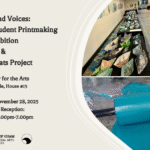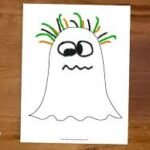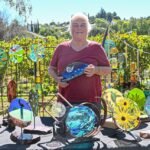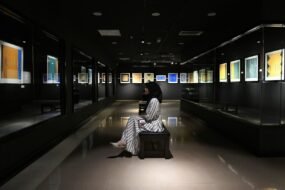
Imagine an abstract modernist in Paris who went there as far back as 1967 on a French Scholarship from Cholamandalam, dabbled in printmaking studios and finally decided he would immerse himself in the world of geometry and symbolism. At Lalit Kala Akademi in Chennai, ‘A Thousand Universes’, pans out like an elegant elegy to his elder brother, the philosopher-poet Akkitham Achuthan Namboothiri, who was also Jnanpith Award Winner ( 2019).

Tonal progressions
Canvases, watercolours and pensive etchings all come together to create a carnival of compositions. Tonal and chromatic progressions obtained through fine oppositions of dense coloured triangles and rectangular planes become the credo. Surface effects, obtained through the dynamics of the artisanal application of paint, are laced with light to create an uncanny alchemy of cadences. Integrity and modernistic caprice create their own perceptual parameters and this is what defines the odyssey.
Chromatic colour tones
Chromatic indices surface in works that are richly textured in soothing blacks, charcoal, ash laden as well as earthy maroons and deep scarlet-toned wonders that celebrate geometry and symbolism of the deepest tenor.
When he chooses to use contrasting colour tones, he exemplifies a loose organization of rectilinear forms as a means of enhancing the relationship between colours, resulting in a vibrant and balanced composition that has been harnessed between layers. A closer look reveals his love for larger compositions that he composes and then divides into several parts—these connotations and permutations keep the human eye riveted. This was a relatively common practice for Akkitham, who seems to have found his own personal perspectives and formal qualities in the separate parts of each cadence of geometric symbolism.

The Triangle that ascertains an aura
Within his own idea of form and process, Akkitham introduces triangular and rhombus-shaped symbols to create his own leitmotif of nuanced patterns in abstraction. The alchemy of short as well as long rectangular as well as curvaceous forms perhaps represent a sense of the tangible world into an otherwise abstract amalgam of shapes and lines that throb within the universe of solitude and silence. Texture has always played a significant role on the canvas with both added as well as recessive dimensions throughout, and the bordering layered pigments further create multiple spatial dimensions against Akkitham’s primarily strong -and-light contrasts in the matrix of his summaries and associations.
The triangle is Narayanan’s metaphor for nature. Narayanan explained that the triangle was one of the main shapes found in nature (snowflakes, plants, as well as stars) and is extolled in the parallelism of religions: the trinity in Christianity or the trimûrti in Hinduism. The triangle for him represents the sky, the earth and the abyss of the core too, and therefore the universe.

Scribbles in Malayalam script
Within his deep, moody colour intensities, we see a weaving of the scribbling of script in Malayalam. As too as you see it, you sense a fluid flow of melodies in a raaga. The obvious musical features of Narayanan’s works are the surging of hymns that rise or fall in rhythms, with brief or broad arching nuances. Music is an intimate part of his being, from kirtanas and ragas in his early years, and later being listening to his wife Sachiko playing classical pieces on the piano. The notes are transmuted into visual qualities, and they seem to simmer sometimes and flood into cadences through all his work. The effect of many of his paintings is like a passage out of the many parts of a raga or a symphony.
Translating into a symbolism and exploration of dichotomies, representations of Narayanan’s lifelong quest to distill an ultimate, higher meaning through paint, these works echo voices of many generations.

Mosaic moorings
A number of these dark, brooding charcoal chimed works are a revisitation wherein a painting becomes the instant expression of his traditional philosophy of aesthetics and art. Akkitham has an extraordinarily innovative exploration of minimalist form. Deeply influenced by modernist abstract teachings and his own investigations into gridded forms, Akkitham’s dynamics often serve, as in the present work, as a self-referential investigation into the structure of mosaic moorings themselves, emphasizing the interplay of lighter and darker shades of the passages of time.

When he uses a succulent green in some works, Narayanan brings to us ‘ nature in its primal form (la nature naturée).’The French Professor Annie Montaut termed, ‘created nature (la nature naturante), ’ of the works of Sayed Haider Raza’s landscapes, and here we are reminded of her words as we see the mossy greens and blue skies peep through the matrix of Narayanan’s canvasses.
Watercolours
There is a sense of lithe and light as well as personal magic and power in his watercolours that form work an art historical canon of Indian contemporary art. Akkitham’s style of abstraction transforms concrete forms into flowing and fractured and fragmented essence, We see that visible forces and elements that are hidden in nature remain his source of inspiration as he linked the natural world closely to the cosmology of the process of both transmutation and rebirth.

Stirring etchings across ages
The last series are a set of stirring etchings in darker tones and riveting compositions. Interestingly, Akkitham began his journey as a printmaker in the most famous studios in Paris. In his printmaking years in Paris (1967-1968), he even joined and spent some weeks in different ateliers, namely Atelier 17 ( William Hayter ), Henri Goetz, and Johnny Friedlaender.
The compositional clarity of lines in these etchings reminds us of his love of stained glass windows as well as the zeitgeist of the triangle. The first fruits of Narayan’s early love for composition … lie within the tradition of medieval glass windows he saw in India as well as Paris. These etchings from the 1970s to 1980s remind us of glass fragments of varying shapes, sizes, and densities, which act as carefully articulated colour areas . These etchings are filled with resonance and are highly expressive, reflecting the intellectual energy and perceptual discipline that went into them.
He also says that he learned the fundamental techniques after he started to hear about printmaking practices from artists like Krishna Reddy, and Somnath Hore.
Narayanan says: After a few weeks, I finally joined Ensba Paris and studied under Prof. Loucian Couteau. Then I started getting acquainted with Krishna Reddy, and a little later, I had opportunities to explore différant techniques of printmaking like viscosity, colour etching, engraving, aquatint, as well as mezzotint, wood and linocut, etc. The study of graphics in those years helped me survive since the scholarship was not sufficient to live on.
I also was fortunate to have done several editions of Graphics for editors in France, Germany, and Italy,I had the chance to make an album with selected text from Soundarya Lahiri edited by Steinto Verlag and Burgdof.
in 1974 and with the Poems of Dominique Buisset titled In The Fictive Gardens edited by Gilles Gaulthier, Paris,in 1984.”

For all art lovers in Chennai the Lalit Kala Akademi’s unveiling of Akkitham Narayanan’s select retrospective is an amalgam of rhythmic abstract compositions of geometry and symbolism born of the chromatics of colour created within the layers of intense depths and fondness for relentless experimentation with techniques and materials that characterise a rich practice over 60 years. For Artworld in Chennai, this exhibition pans out like a magnum opus. As Artworld celebrates 60 years of its existence the brilliant Sarala Daruwala Banerjee can raise a toast to unveiling an Indian abstract master who traveled from Kerala to Cholamandalam and then to Paris to create his own odyssey within the orbit of transcending colour and charismatic complexities in contours.This seminal show runs at LKA Chennai till April 15th, 2025.
Images: KEYABALA
Disclaimer
Views expressed above are the author’s own.
END OF ARTICLE











